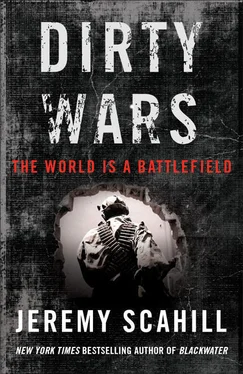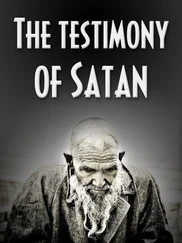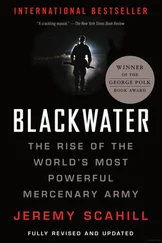SOMALIA COULD HAVE TURNED OUT very differently from the country the United States and its warlords helped create after 9/11. Radical Islam was new to Somalia and was not widespread prior to the launch of the Global War on Terror. Many seasoned Somalia analysts believed that the handful of radicals in the country could have been contained and that the central aim of stabilizing the country should have been to disarm and disempower the warlords. Instead, Washington directly supported an expansion of their power and, in the process, caused a radical backlash in Somalia, opening the doors wide for al Qaeda to step in. While the CIA began cultivating its relationship with Qanyare and other warlords, the official government of Somalia watched from the sidelines. Made up of Western-educated technocrats, the “Transitional National Government” was little more than an idea that existed in hotel suites and coffee shops in Kenya and other neighboring countries. And Washington’s counterterrorism agencies treated it as such.
After the 9/11 attacks and President Bush’s “Either you are with us or you are with the terrorists” declaration, Somalia’s foreign minister, Ismail Mahmoud “Buubaa” Hurre, swiftly penned a letter to the US secretary of state. “We are with you, and we are as much concerned with the possibility of Al Qaeda moving into [Somalia] as you are,” Buubaa recalled writing. “But,” he told me over coffee at a posh hotel in Nairobi, “the response was lukewarm.” Instead of strengthening the Somali government, he said, “they started cooperating with the warlords, thinking that the best way to combat terrorism was to help the warlords become stronger, and chase away the fundamentalists from Somalia. That backfired.”
On September 23, 2001, President Bush had signed Executive Order 13224, designating more than twenty-five groups and individuals as terrorists that could be targeted in the Global War on Terror. Ultimately the list would grow to more than 180. The order was officially a means “to disrupt the financial support network for terrorists and terrorist organizations,” but it also revealed groups that could potentially be targeted militarily. Among the original targets was a Somali group, Al Itihaad al Islamiya (AIAI). Despite the fact that the group had largely disbanded prior to 9/11, it was often used as a generic umbrella under which to classify Islamist militants in Somalia. AIAI had participated in the insurrection against the UN peacekeeping force in Somalia in the 1990s and took credit for a series of terrorist attacks and assassinations in Ethiopia. Allegations of an al Qaeda connection to the Black Hawk Down incident were largely linked to AIAI. Its inclusion in 13224 was an indication that the Bush administration was considering striking inside Somalia.
US war planners believed that when American forces invaded Afghanistan, al Qaeda operatives and other jihadists would seek refuge elsewhere. Yemen and Somalia were among the presumed destinations, so Washington and its allies set up a flotilla, known as Task Force 150, charged with intercepting the jihadists headed there. Speaking from NATO headquarters on December 18, 2001—following a briefing Rumsfeld gave to the defense ministers of member nations—German defense minister Rudolf Scharping told reporters that a US incursion into Somalia was “not a question of ‘if,’ but of ‘how,’ and ‘when.’” Rumsfeld wasted little time denying what he called “a funny report about some German saying something,” telling reporters at a DoD press briefing the following day that “the German was wrong.” “He didn’t mean to be, and he’s probably sorry,” Rumsfeld continued. “But he was flat wrong.”
Although US forces did not immediately move into Somalia—with Afghanistan and Pakistan the top priorities—the expanded US base at Camp Lemonnier in Djibouti was rapidly becoming a hub in the Horn of Africa for JSOC and the CIA. The base would be tasked with keeping watch over Somalia, along with Yemen, its neighbor across a narrow sliver of water. Scharping may have been wrong in the short term, but “flat wrong” would prove to be an exaggeration. A few days after Rumsfeld denied US plans to move on Somalia, Secretary of State Colin Powell said Somalia’s instability made it “ripe for misuse by those who would take that chaos and thrive on the chaos,” adding, “That’s why we’re really looking at Somalia—not to go after Somalia as a nation or a government, but to be especially sensitive to the fact where Somalia could be a place where people suddenly find haven.”
US officials in East Africa were also concerned that Kenya could potentially turn into a Pakistan of sorts, providing a hideout for an al Qaeda network they believed was “rebuilding its infrastructure in Kenya.” Some within the US military began agitating for a robust, full-time US military presence in the Horn of Africa, and the news media were rife with speculation about Washington’s agenda in Somalia. “The possibility of terror cells being in Somalia is real,” declared Walter Kansteiner, who headed up the Africa division at the State Department at the time. “Identifying Somalia as a terrorist base for bin Laden’s al Qaeda and other extremist organizations, U.S. reconnaissance planes…reportedly began surveying targets from the sky, while military and CIA agents contacted potential allies both inside Somalia and in neighboring Ethiopia,” according to the San Francisco Chronicle . Deputy Defense Secretary Paul Wolfowitz said that in assessing terror threats in the Horn of Africa, “People mention Somalia for obvious reasons. It’s a country virtually without a government, a country that has a certain al-Qaeda presence already.”
Like the government of Ali Abdullah Saleh in Yemen, the ruling elites in Kenya and Ethiopia saw opportunity in the threat of terrorism after 9/11. Both governments welcomed increased US counterterrorism assistance, training of their forces and financial support in return for their assistance and allowing territorial access to US forces. Ethiopia, a longtime nemesis of Somalia, saw the country’s indigenous Islamists as a threat and aggressively pushed the line that al Qaeda was a creeping menace to its neighbor to the east. While regional stakeholders invoked a burgeoning terrorist threat and rumors spread about possible US operations in Somalia, eminent analysts of the country’s affairs were referring to the al Qaeda threat there as “small potatoes.” “There’s no need to be rushing into Somalia,” former US ambassador to Ethiopia David Shinn said at the time. “If you think about military targets, I doubt they exist.” Davidson University professor Ken Menkhaus, a Somalia scholar who had written several papers on political Islamic tradition in Somalia prior to 9/11, estimated that the number of Somali nationals with “significant links” to al Qaeda was between ten and twelve. A few foreign fighters might also be holed up there, but because of a dearth of intelligence—Shinn referred to it as “abysmal”—“snatch and grab” type tactics would be ill-advised, he warned.
Although some within the military, CIA and Bush administration wanted to hit in Somalia, those plans would have to wait. The Combined Joint Task Force for the Horn of Africa in Djibouti would largely take on a watch-and-wait posture, and many of the commandos, including JSOC and CIA assets, originally deployed to Camp Lemonnier post-9/11, would be refocused on the impending invasion and occupation of Iraq. As a former member of the Special Operations Command’s Horn of Africa Task Force told me, there was initially a determination to “bring the full resources of the United States military, and specifically the Special Operations Command to bear. And we were going to ensure that [al Qaeda] would not be able to reconstitute themselves, or use any part of the Horn of Africa as a safe haven, for operations against the United States.” However, he explained, “it did not turn out that way, to our detriment. At some point, the top policy makers made the decision that the preeminent national security threat to America was Iraq. And when the focus shifted to Iraq, the resources went with it. And that led to a lack of focus, and, more egregiously, a lack of resources within and around the Horn of Africa.” JSOC’s role in Somalia during the early years after 9/11 was relegated to in-country protection for the CIA, establishing surveillance equipment on the ground and having a team on standby in Djibouti, ready to swoop in if anything went wrong with the small CIA-led teams running the warlords.
Читать дальше












